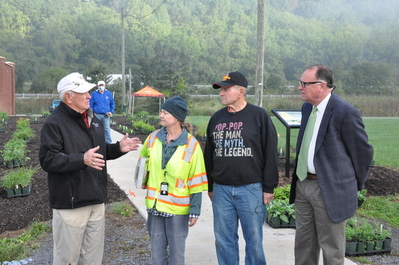* * * * *
 | Covington-Hot Springs Rotary members, from left, Bill Wilson and Paul Linkenhoker are joined by VDOT's Stacey Moulds (VDOT Pollinator Habitat Coordinator) and State Sen. R. Creigh Deeds (far right) on Friday, September 24, 2021, discussing the VDOT pollinator program. They were all onsite at the VDOT rest stop in the Longdale area as the program was being implemented. (Staff photo by Judy Moffitt Clark for the AlleghanyJournal.com)
|
|
| Covington-Hot Springs Rotary Club Plants Change As Part Of VDOT Pollinator Habitat Program
|
|
Clifton Forge, VA (Sept. 24, 2021) - Beds of native plants can potentially provide enormous benefits to a wide variety of threatened and dwindling pollinator species. That is the goal of a planting project performed by the Covington-Hot Springs Rotary Club as part of the Virginia Department of Transportation Pollinator Habitat Program.
On Friday morning, September 24, members of the Rotary Club gathered at the Interstate 64 east truck safety rest area in Alleghany County to perform their work. The plants were placed in prepared beds totaling 2,000 square feet in size. The beds were prepped by a VDOT contractor. All of the plants are native perennials and grasses, most of them native to the region.
This pollinator waystation is a hands-on and educational opportunity that serves the program and local community.
The VDOT Pollinator Habitat Program strives to create natural areas of native plants along state-maintained roads and properties. These areas provide habitats to threatened and dwindling pollinator species, which include honey and native bees, butterflies, birds, bats, flies and beetles. Pollinators contribute to the U.S. economy by keeping fruits, nuts and vegetables fertilized through a process of moving pollen from one flower or plant to another. Only fertilized flowers can make fruit and seeds.
Throughout the Commonwealth of Virginia pollinator beds can be found at various interstate rest areas. Signs indicate the location of these beds, which can serve as an educational spot for all travelers while making viable habitats available to many pollinator species. The number of waystations continues to grow with a focus on natural gardens and meadows at rest areas, park-and-ride lots, and additional VDOT properties.
These locations have reduced mowing so that plants can mature and produce seeds. Additionally, the plantings increases native vegetation to stabilize slopes and reduce erosion. Deep roots of native plants also decrease storm water runoff. Pollinator plantings help to decrease invasive species to reduce the costs of removing problem vegetation and using herbicides.
Funding for the VDOT Pollinator Habitat Program comes from purchases of the Wildflower and Protect Pollinators license plates. The plates are available for purchase through the Virginia Division of Motor Vehicles (DMV).
For more information on the Pollinator Habitat Program visit the VDOT website at VirginiaDOT.org and type pollinator in the search bar or go to this link: www.virginiadot.org/programs/pollinator_habitat_program.asp
The VDOT Staunton District serves Frederick, Shenandoah, Clarke, Warren, Page, Rockingham, Augusta, Highland, Rockbridge, Alleghany and Bath counties. | | | | | |
| * * * * * |

BACK TO THE JOURNAL'S HOMEPAGE!
* * * * *
KEEP UP WITH THE LOCAL NEWS! SIGN UP FOR ALLEGHANY JOURNAL BREAKING NEWS BELOW!
FREE Breaking News Sign Up Here!
|
|


